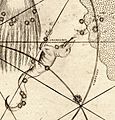Musca (constellation) facts for kids
| Constellation | |

List of stars in Musca
|
|
| Abbreviation | Mus |
|---|---|
| Genitive | Muscae |
| Pronunciation |
|
| Symbolism | the Fly |
| Right ascension | 11h 19.3m to 13h 51.1m |
| Declination | −64.64° to −75.68° |
| Quadrant | SQ3 |
| Area | 138 sq. deg. (77th) |
| Main stars | 6 |
| Bayer/Flamsteed stars |
13 |
| Stars with planets | 3 |
| Stars brighter than 3.00m | 1 |
| Brightest star | α Mus (2.69m) |
| Messier objects | none |
| Meteor showers | ????? |
| Bordering constellations |
|
| Visible at latitudes between +10° and −90°. Best visible at 21:00 (9 p.m.) during the month of May. |
|
Musca is a small but interesting constellation found in the southern sky. Its name means "the Fly" in Latin. It's one of the many constellations that look like an animal or object.
Many of Musca's brightest stars are part of a huge group called the Scorpius–Centaurus Association. This is a loose collection of hot, blue-white stars. These stars seem to have formed together and move across the Milky Way galaxy as a group.
Contents
Finding Musca in the Sky
Musca is a southern constellation, meaning you can only see it from the Southern Hemisphere. It's located near the famous Southern Cross (the Crux constellation). This makes it easier to find in the night sky.
Neighboring Constellations
Musca is surrounded by several other constellations. These include Apus (the Bird-of-Paradise) and Carina (the Keel). It also borders Centaurus (the Centaur), Chamaeleon (the Chameleon), Circinus (the Compass), and Crux (the Southern Cross).
Stars of Musca
Musca has a few notable stars, even though it's a small constellation. The brightest star in Musca is called Alpha Muscae. It shines with a magnitude of 2.69, which makes it quite easy to spot.
Brightest Stars
Alpha Muscae is a very hot, blue-white star. It's much bigger and brighter than our Sun. While it looks like a single star, it might actually be a system of two stars.
Nearby Stars
One of the closest stars to our solar system in the direction of Musca is LP 145-141. This star is about 15 light-years away from Earth. A light-year is the distance light travels in one year.
Deep Sky Objects in Musca
Musca is home to some amazing objects that are not stars. These are often called "deep-sky objects." They include nebulae and star clusters.
The Coalsack Nebula
Part of the famous Coalsack Nebula extends into Musca. The Coalsack is a huge, dark cloud of dust and gas. It blocks the light from stars behind it, making it look like a dark patch in the Milky Way. It's one of the most well-known dark nebulae in the sky.
The Dark Doodad Nebula
Another interesting dark nebula found in Musca is the Dark Doodad Nebula. This nebula looks like a long, thin column of dark dust. It's a fascinating sight for astronomers.
History of Musca
Musca is one of the constellations created in the late 16th century. It was first drawn on a celestial map by Dutch astronomers.
Origin of the Constellation
The constellation Musca was first described by Petrus Plancius. He was a Dutch astronomer and cartographer. It appeared on a celestial globe in 1597 or 1598. It was later included in Johann Bayer's famous star atlas, Uranometria, in 1603. Originally, it was called Apis, meaning "the Bee." Later, its name was changed to Musca, "the Fly."
Images for kids
-
The Coalsack Nebula can be seen as the large, dark region near the top of the photo. It extends into the northeast of Musca. The vertical dark column in the lower right of the image is the Dark Doodad Nebula.
See also
 In Spanish: Musca para niños
In Spanish: Musca para niños



